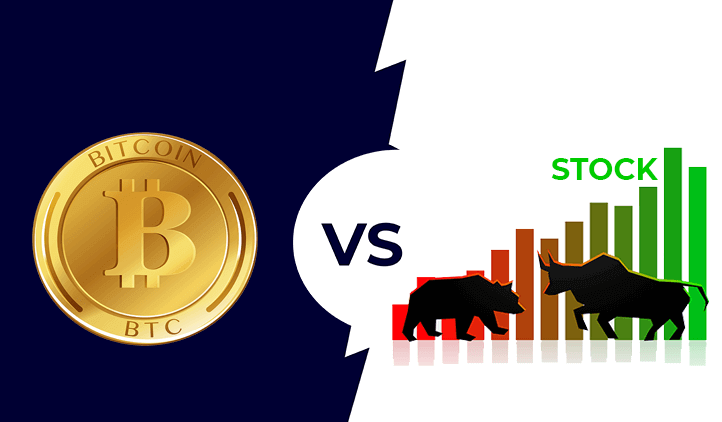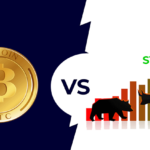As the S&P 500 hits a new all-time high, the crypto market has been quick to react. Investors and analysts are keeping a close eye on the relationship between traditional markets and digital assets, as expectations for fewer Federal Reserve rate cuts and a strong U.S. economy bolster confidence. But what does this mean for Bitcoin and other cryptocurrencies?
The Crypto Market’s Immediate Reaction
When the S&P 500 recently reached an all-time high of 5,819 points, the broader financial markets took notice. Not to be left behind, Bitcoin surged by more than 5%, reaching $62,926. The surge in both traditional and digital markets highlights a correlation that has been gaining traction in recent years—when the stock market thrives, cryptocurrencies often follow suit.
The overall crypto market capitalization also climbed above $1.23 trillion, as investors poured capital into digital assets. However, despite this short-term boost, some market observers remain cautious, particularly as traders and analysts are still digesting inflation data and the Federal Reserve’s monetary policy outlook.
Stock Market Rally: A Boon for Bitcoin
The S&P 500’s historic rise in 2024 has been a key driver behind the crypto market’s strength. With year-to-date gains of over 22%, the S&P 500 is on track for its best annual performance since 1997. This rally in traditional financial markets has instilled confidence in Bitcoin investors, as the cryptocurrency benefited from a broader appetite for risk assets.
At the time of writing, Bitcoin’s price is fluctuating around the $62,900 mark, with many analysts pointing to $63,900 as a critical level of resistance. Should Bitcoin surpass this level, it could trigger another bullish breakout, driving the price further upward. On the flip side, a dip below $60,200 could signal another pullback, potentially setting the stage for a period of consolidation.
A Symbiotic Relationship: Stock Market and Crypto Market
Historically, many believed that cryptocurrencies acted as a hedge against traditional financial markets, providing diversification and risk reduction for investors. However, recent trends suggest a stronger coupling between the two asset classes than previously anticipated.
Empirical data supports this view, showing that shocks in the S&P 500 returns tend to spill over into the crypto market, impacting the price of digital assets. Interestingly, the reverse is also true, though to a lesser extent—shocks in crypto returns can also lead to reactions in traditional stock markets, albeit less dramatically. This two-way relationship is a sign of the growing importance of cryptocurrencies within the broader financial ecosystem.
However, this linkage raises important questions for investors. As the S&P 500 continues to rise, many wonder if Bitcoin and other cryptocurrencies will maintain their upward trajectory. On the other hand, should the stock market experience a pullback or volatility due to macroeconomic factors, the crypto market may also see increased volatility.
Inflation Concerns Drive Bitcoin’s Value Amid Fed’s Rate Cuts
One of the key factors influencing the current market environment is inflation. Recently, the U.S. Producer Price Index (PPI) came in at 1.8%, surpassing the expected 1.6%. This hotter-than-expected inflation data is causing concerns about the Federal Reserve’s ability to control price increases in the long term.
Interestingly, inflation concerns are also boosting Bitcoin’s reputation as a hedge against inflation. As inflationary pressures build, Bitcoin has often been seen as a store of value and a safe-haven asset, similar to gold. This narrative has helped to drive Bitcoin’s recent price gains, as investors seek shelter from traditional fiat currency devaluation.
Meanwhile, the Federal Reserve’s decision to cut interest rates by 50 basis points further fueled optimism across both traditional and crypto markets. This move was widely anticipated and has given equities and cryptocurrencies fresh momentum, even as investors remain cautious about future rate cuts.
According to the latest market projections, there is an 88% chance that the Fed will implement an additional 25 bps cut in November. Should this come to pass, it could provide another boost to both the stock and crypto markets, as lower interest rates typically lead to more liquidity and higher risk appetite among investors.
Will the Crypto Market Keep Falling?
Despite the recent rally, market watchers remain divided on the future direction of the crypto market. On one hand, the combination of rising inflation, Fed rate cuts, and record highs in the S&P 500 creates a bullish environment for Bitcoin and other cryptocurrencies. On the other hand, the potential for volatility remains, particularly as the Federal Reserve’s next move could either fuel further gains or cause a sharp reversal.
If inflation data continues to come in higher than expected, it is possible that the Fed may delay or slow its rate-cutting strategy. In that case, we could see a pullback in both the stock and crypto markets, especially if traders begin to take profits after such strong year-to-date gains.
Critical Price Levels to Watch
Looking ahead, several critical price levels will be closely monitored by traders and analysts:
- $63,900: This is a key resistance level for Bitcoin. Should Bitcoin break through this barrier, it could open the door for further upside potential.
- $65,000: Another significant level of resistance. Surpassing this threshold would likely signal a continuation of the bullish trend, drawing in additional buyers.
- $60,200: This is a key support level. A dip below this mark could trigger another pullback, potentially creating a bearish outlook in the near term.
Conclusion: Mutual Coupling Between Stock and Crypto Markets
The evidence of a two-way relationship between the S&P 500 and the crypto market challenges the notion that cryptocurrencies are an independent hedge. Instead, the spillover effects between the two markets appear to be stronger than initially thought, signaling that traditional and digital assets are more intertwined than ever before.
While this mutual coupling may create opportunities for investors, it also increases the risk of synchronized downturns. Investors should remain vigilant, especially as inflation, Fed policy, and broader economic trends continue to shape the outlook for both markets.
As the crypto market continues to mature, its relationship with traditional financial markets will undoubtedly evolve. For now, the new all-time highs in the S&P 500 are driving optimism across both asset classes, but future developments will be closely watched for any signs of divergence.
For crypto enthusiasts and investors alike, the question remains: can Bitcoin and the broader market maintain their upward momentum, or is a correction on the horizon?
ENG WANJIKU
Views: 14




